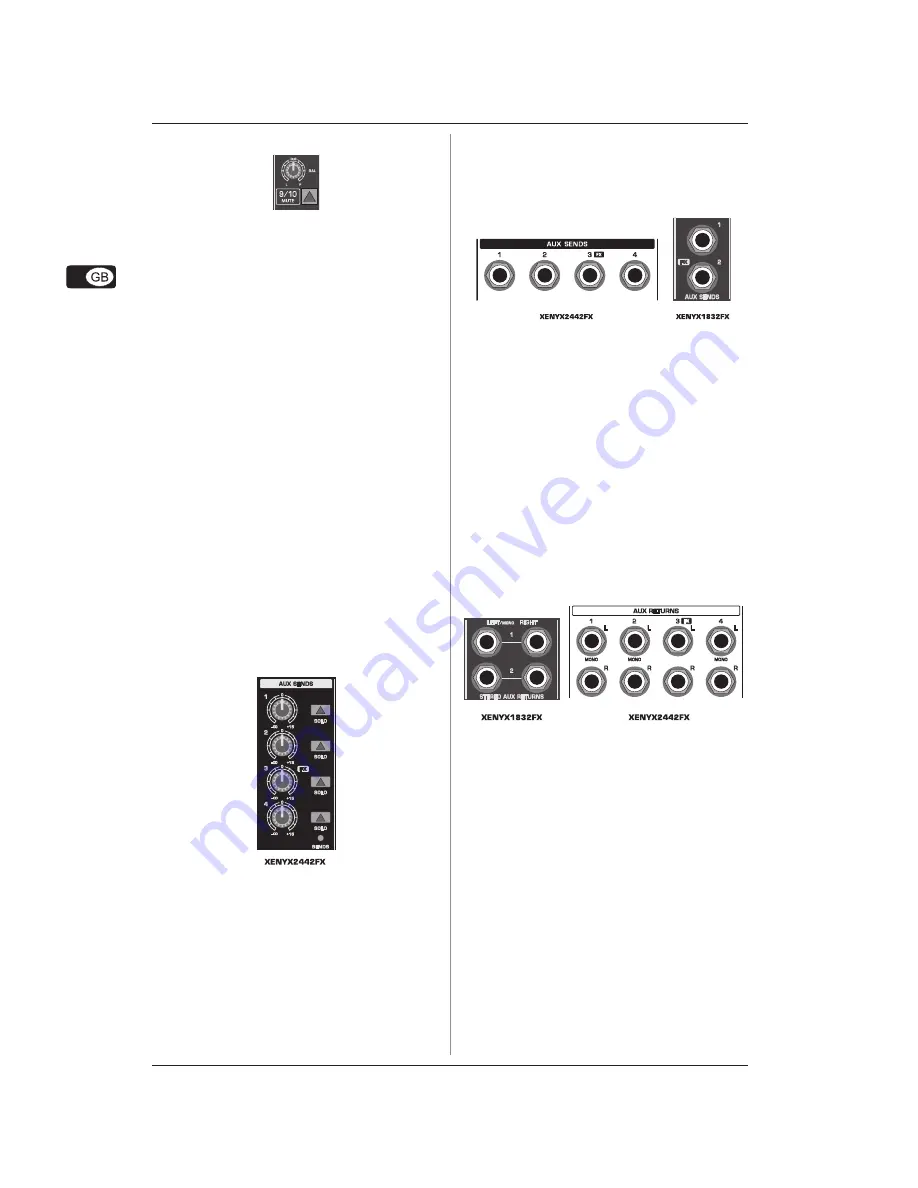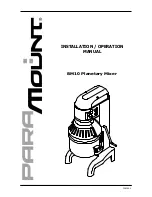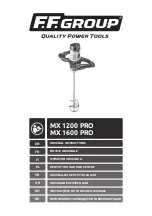
8
XENYX 1622FX/1832FX/2222FX/2442FX
+
If you want to monitor the signal of just one AUX
bus, none of the other SOLO SWITCHES should be
pressed and the MODE switch should be in the SOLO
position (not depressed).
2.3.2 Aux send jacks
Fig. 2.8: Aux send jacks
AUX SEND jacks
The
AUX SEND
jack should be used when hooking up a monitor
power amp or active monitor speaker system. The relevant aux
path should be set pre-fader.
+
On the 2222FX, aux send 1 is hard wired
as pre-fader and hence called MON. Model 1832FX
has a dedicated monitor output (MON OUT jack), cf.
chapter 2.3.4.
As already mentioned, the aux sends in the channelsif set
post-fadercan be used to connect to external effects devices.
AUX SEND (FX)
The
AUX SEND (FX)
jack carries the master aux mix (from the
channels FX controls). You can connect this to an external
effects device to process the FX bus. The processed signal can
then be brought from the effects device back into the STEREO
AUX RETURN jacks.
2.3.3 Stereo aux return connectors
Fig. 2.9: The aux return connectors
+
On the 2222FX, 1832FX and 1622FX the STEREO AUX
RETURN jacks are located on the front panel of the
unit.
STEREO AUX RETURN
The
STEREO AUX RETURN 1
jacks generally serve as the
return for the effects mix (created using the post-fader aux
sends) by connecting the output of an external effects device. If
only the left jack is connected, the AUX RETURN is automatically
switched to mono.
+
You can also use these jacks as additional line
inputs.
All stereo aux returns are balanced, but can of course also be
used with unbalanced connectors. If you use an aux send for
monitoring, the associated unused stereo aux returns are
available for other line level signals (e.g. keyboards).
+
A signal fed into the stereo return jacks can be
output via an aux send jack. More information on
this can be found in chapter 2.3.5 STEREO AUX
RETURN 1/2 (TO AUX SEND).
STEREO AUX RETURN FX
The
STEREO AUX RETURN FX
jacks accept the effects mix
2.2.4 Routing switch, solo and channel fader
Fig. 2.6: Balance control and mute switch
BAL
The
BAL
(ANCE) control has a similar function to the PAN control
in the mono channels.
The balance control determines the levels of the left and right
input signals relative to each other before both signals are routed
to the left/right main mix bus (or odd/even subgroup).
The remaining control elements in the stereo channels perform
the same functions as their counterparts in the mono channels
(MUTE switch, MUTE and CLIP LEDs, SOLO switch, SUB and
MAIN switches and channel fader).
2.3 Interface panel and main section
Where it was useful to trace the signal flow from top to bottom
in order to gain an understanding of the channel strips, we now
look at the mixing console from left to right. The signals are, so to
speak, collected from the same point on each of the channel
strips and then routed to the main section all together.
2.3.1 MON control, aux sends 1, 2 and 3 (FX)
Turning up the AUX 1 control in a channel routes the signal to
the aux send bus 1.
+
As the 1832FX is equipped with an additional monitor
path, its first aux control in the channel strips is
named MON. The console also has a dedicated
master fader (MON SEND) for this aux path.
AUX SEND 1, 2 and 4
The
AUX SEND 1
control governs the master send level of the
mix created by the individual channel AUX 1 sends.
Likewise, the
AUX SEND 2
contol is the master control for the
aux 2 bus, and
AUX SEND 4
controls the AUX 4 bus.
Fig. 2.7: The AUX SEND controls of the main section!
AUX SEND 3 (FX)
The
FX
control determines the signal level for effects
processing, i.e. regulates the level to an external (or the inter-
nal) effects device.
1622FX and 1832FX: On these consoles, this function is
performed by the AUX SEND 2 control (FX).
SOLO
You can use the SOLO switch to separately monitor the aux
sends via the CONTROL ROOM/PHONES outputs and check
these with the level meters.
2. CONTROL ELEMENTS AND CONNECTORS



































